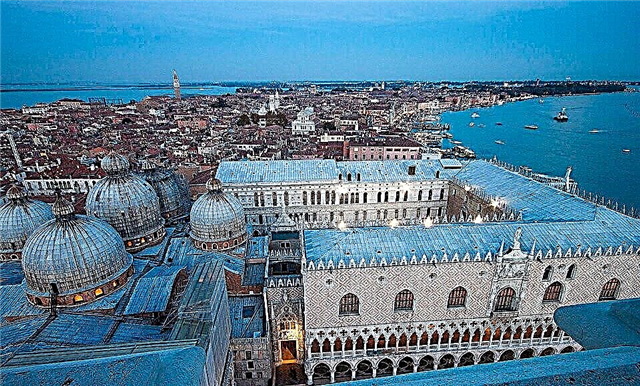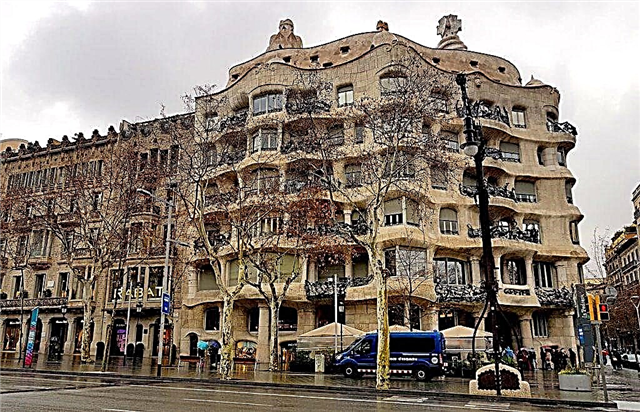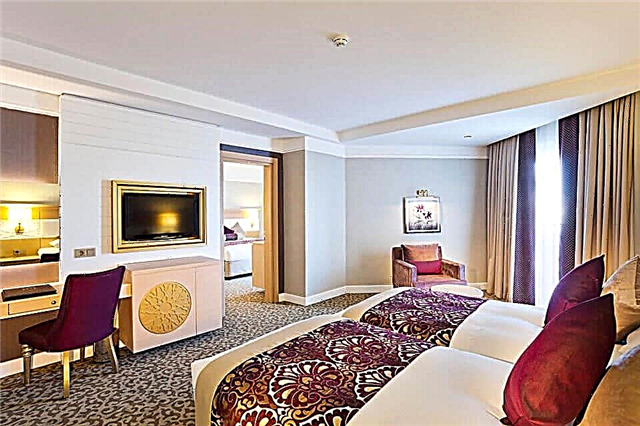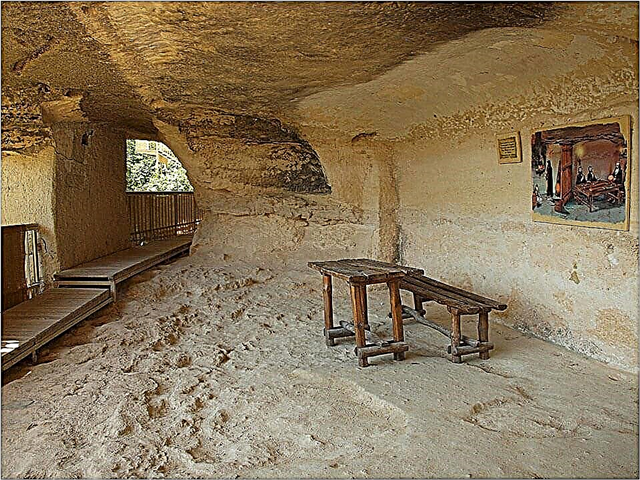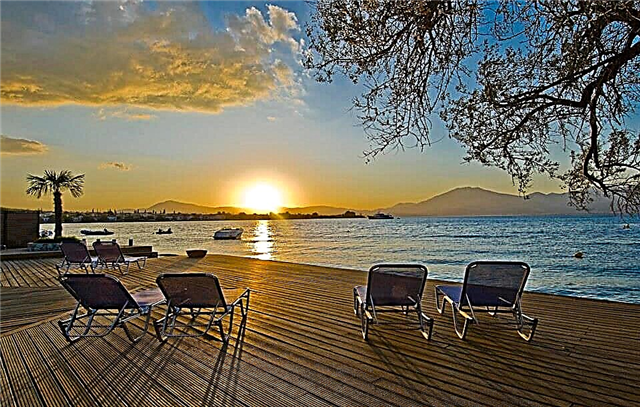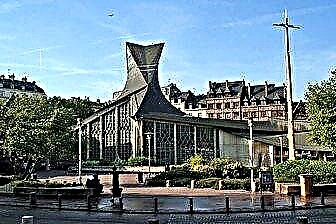Normandy is a land of tranquil rural landscapes, lush meadows, beautiful Gothic castles and ancient legends. This is the land of the famous William the Conqueror, who practically laid the foundation for the history of neighboring England as a state. In Norman Rouen, the legendary Maid of Orleans, Jeanne D'Arc, was convicted and executed. Nowadays, an elegant temple rises next to the place of its burning.
The streets of Rouen are a real museum of Gothic architecture. Several hundred houses have been built here in the magnificent Flaming Gothic style. The exquisite facades and spiers of the Palace of Justice, decorated with fine stone lace, and the incredible stained glass windows of the Rouen Cathedral delight even people indifferent to architectural beauty.

The best hotels and hotels at affordable prices.
from 500 rubles / day
What to see and where to go in Rouen?
The most interesting and beautiful places for walking. Photos and a short description.
Place Vieux-Marché
The legendary Jeanne D'Arc, the heroine of the Hundred Years War, canonized by the Catholic Church in the 20th century, was burnt on the Vieux-Marché square. Many buildings surrounding this place are somehow associated with her name. On the square there is a museum dedicated to the memory of Jeanne, as well as a monument surrounded by flower beds and marking the place of her execution. Along the perimeter of the square, there are elegant half-timbered houses that adorn the city landscape.

Rouen Cathedral
The cathedral is one of the most striking monuments of Gothic architecture in France. It was built in the 13th century on the foundations of an 11th century Romanesque church. The archbishop's palace adjoins the temple, which forms a single architectural complex with it. The bell tower of the cathedral is 151 meters high. The architecture of the temple made a strong impression on the artist C. Monet, who created a series of paintings dedicated to the cathedral.

Abbey of Saint Ouen
The abbey was founded in the 6th century and gradually became the most influential monastery in Normandy. The monastery existed until the 9th century, when pagan Normans ruined it. The restoration took place in the 11th century under William I the Conqueror. The first church of the monastery was built in the Romanesque style, later in the XIV-XVI centuries. the building was rebuilt in accordance with the canons of the Gothic style.

Saint Maclou Church
The temple is built in a picturesque style of flaming Gothic. Its spiers really resemble tongues of stone flame, reaching up to the heavens. The church was built in the period 1437-1521. on voluntary donations from patrons. The temple is adorned with brightly crafted 15th century stained glass windows and exquisite decorative elements. During the Second World War, the temple was partially destroyed, the restoration was completed in 2010.

Abbey of Saint-Georges-de-Beaucherville
Benedictine monastery of the XI-XII centuries, which was badly damaged during the religious wars between Protestants and Catholics. Some of the buildings had to be rebuilt, so the abbey has buildings from both the 12th century and the 17th century, and there is some mixing of architectural styles. Around the monastery there is a picturesque French park with hedges, an orchard and a vegetable garden of medicinal plants.

Church of St. Jeanne D'Arc
The temple is located in the Place Vieux-Marché. In the 16th century, a Gothic cathedral stood in its place, of which only stained-glass windows remained. The Church of Saint Jeanne was built in a modern manner using asymmetric architectural forms and interesting engineering solutions. The roof of the structure symbolizes the flames in which Jeanne died. The complex of church buildings also includes a covered market.

Jeanne D'Arc Tower
The tower is the only surviving building of the Rouen Castle, which was erected for Philip II Augustus. Local limestone was used to build the fortifications. The building was destroyed during the religious wars. The donjon tower is famous for the fact that the trial of the Virgin of Orleans was held here in 1431. However, Jeanne was kept in captivity in another tower, now destroyed.

Palace of Justice
The palace is considered one of the most picturesque buildings in Rouen. It was built in the 16th century by R. Le Roux and R. Ango and was used for city council meetings. The building is a striking example of secular Gothic. Nowadays, the local court sits in the palace, there are also two museums and a library here. The palace facade resembles a fancy stone lace, its decorative details are so skillfully executed.

Museum of Fine Arts
The gallery is one of the largest in Normandy, its permanent exhibition is located in 60 rooms. The collections of the 17th and 19th centuries are considered especially significant and complete. The collection contains works by Modigliani, Renoir, Lancre, Moreau, Monet and other masters. In addition to paintings, the museum collection includes sculptures, graphics, jewelry and furniture. The museum constantly hosts temporary exhibitions of famous and recognized artists.

Blacksmithing Museum
The museum has existed since the 19th century; it is housed in a church building from the 16th century. Initially, the exposition was located in Paris, later it was transported to Rouen. The collection of the museum contains works of art forging from the Roman period to the 20th century. Many exhibits were brought from Arab and Asian countries, as well as from Russia. In the museum you can see wrought iron grates, utensils, decorative railings, signboards and much more.

Panorama XXL
An interactive exhibition that immerses visitors in the atmosphere of different eras. "Panorama" is a huge metal cylinder 34 meters in diameter and 35 meters in height. Inside this cylinder is a circular volumetric fresco that reproduces the chain of events of a certain historical period. In 2015, it was 312 - the time of the adoption of Christianity by Emperor Constantine, in 2016 - a panorama of Rouen from the time of Jeanne D'Arc.

Museum of ceramics
The collection is housed in a historic 16th century mansion. Here are collected exhibits related to the period of the XVI-XIX centuries. For the first time on the territory of France, the secret of making faience was revealed by a resident of Rouen. Until that moment, only Italian masters owned the secret. By the 17th century, Rouen became famous throughout the world for its ceramic products. During a guided tour, you can learn about the technology of making ceramics.

Street of Big hours
Pedestrian street located between the Market Square and the Rouen Cathedral. Along the street there are town houses with half-timbered facades. Its name comes from the old astronomical clock, which is located on a 16th century stone arch. Several centuries ago, they even hired a special caretaker who monitored the serviceability of the mechanism and lived near the arch.

Rouen Botanical Garden
The garden was founded in the 17th century. At first it was a private territory, once even Napoleon Bonaparte owned it. In the 19th century, the garden became the property of the city and became available to everyone. Some parts of the park are closed to the public due to research activities. In the city's botanical garden there is a large rose garden where varieties bred by experts from Normandy grow.

Gustave Flaubert bridge
The bridge of 2008, equipped with lifting structures and with a large capacity. The spans are specially placed high above the water so that large ships can safely pass under them. The supporting columns of the bridge rise 91 meters above the Seine, the length of the spans is more than 1 km. The structure was designed by engineers E. Zublen and M. Virlojo. The cost of construction work was 155 million euros.



